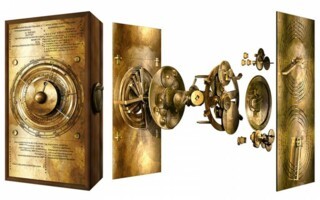Gears within Gears
Liam Shaw
Researchers at UCL have published a complete model for the inner workings and front display of the Antikythera mechanism. The ancient device, recovered from a shipwreck in 1901, has long been thought to have shown a model of the Greek cosmos, with the Sun, Moon and five classical planets rotating around the Earth, controlled by a fiendish set of gears. The UCL team argue that theirs is the first model to match all the existing evidence.
That evidence survives in 82 fragments, discovered fused together in the remains of a small box, initially overlooked in preference to other artefacts in the wreck. The discovery of tiny toothed wheels was a surprise – gears that were older than Christ.
During the 20th century it became clear that the device was a sophisticated calendrical calculator, operated at the side by a small crank. (Over the years it has attracted many of the other kind of crank – it was made by aliens! – as well as serious scholars.) Tony Freeth, the lead author of the new study, is an honorary professor in UCL’s department of mechanical engineering. He has spent the last two decades engrossed in the device’s workings.
In 2005, some of the fragments were scanned using X-ray computed tomography, to reveal hidden inscriptions: thousands of tiny Greek characters, lurking in the layers of corrosion. Freeth and his colleagues argue that there’s now just enough information to nail the details down. Some models, including one made by Freeth and Alexander Jones in 2012, suggested the planets’ positions were indicated on the front panel using co-axial pointers (like a clock with multiple hands); the new model has them represented by semi-precious stones on rotating rings.
Many of the technical specifications of the model have been published before. The new details will be closely scrutinised, but the central insight is compelling. Viewed from Earth, the planets undergo periodic cycles of motion as their movement against the background stars changes direction (when Earth overtakes another planet on its orbit, the other planet appears for a while to be ‘in retrograde’). These patterns repeat, and can be represented as a whole number of cycles in a whole number of years. Such a ‘period relation’ is an approximation to the true repetition, but it can be a very good one.
As well as being mathematically convenient, whole number ratios can be used to recreate the planetary motion mechanically: a mathematical ratio becomes a gear ratio. Ideally, you want numbers that can be divided into small enough prime factors to make gears you can feasibly manufacture (100 teeth seems to have been the limit on the small cogs in the Antikythera mechanism). Even better, if the period relations for different planets have shared factors, they can also share gears, which means you can use the same mechanism to run different planetary motions.
Starting from period relations that are attested in Babylonian astronomical texts, Freeth et al. generated new period relations for the planets, hitting on a particular combination that would work using gears with fewer than 100 teeth. The combination includes ‘surprisingly complex’ periods for Venus and Saturn, as revealed by X-ray CT, but the others are an ingenious inference. The study’s press release claims that the researchers were able to derive these relations by using ‘an ancient Greek mathematical method described by the philosopher Parmenides’. This statement was repeated in news reports, but the truth is more complicated.
The source of the Parmenides claim is David Fowler’s controversial book The Mathematics of Plato’s Academy: A New Reconstruction (1987). Fowler argued that a small section of Plato’s dialogue Parmenides is an obscure allusion to an iterative mathematical algorithm, a way of refining the accuracy of a ratio by working from an initial overestimate and underestimate which gradually converge. The UCL team have followed Fowler in calling this method the ‘Parmenides Process’.
Their puzzle-solving is spectacular: they adapt the algorithm to generate period relations for Mercury, Mars and Jupiter, selecting them on grounds not only of accuracy but also of gear economy. Crediting the original method to Parmenides himself, however, as in the press release, is dubious. Of course, suggesting your arguments date back to Parmenides isn’t a modern tactic: Plato did it too. But it’s a mis-step in a study striving for historical accuracy. (When I put this to Freeth, he graciously admitted I had a point.)
While the proposed gearing works in theory, there’s still the question of whether it could have been made using ancient methods. Such a close-packed gearing system would have been difficult to keep running smoothly. The team plan to construct it, but for now the model is a work of speculative friction. Given the paucity of evidence and the degrees of freedom, it would be astonishing if the precise gearing combination suggested was the one used. But the wiggle room is getting smaller.
It seems impossible that there should have been only one such device. Cicero wrote of similar-sounding ‘spheres’, supposedly made by Posidonius and Archimedes. Serafino Cuomo suggests they may have been like Fabergé eggs – ‘few in number, heard of by many’. However many there were, it’s clear the Greeks were capable of constructing something extraordinary.
Freeth et al. describe the device as taking ‘the first steps to the mechanisation of mathematics and science’, looking more than a millennium ahead to the geared clocks of the medieval period. But the Antikythera mechanism didn’t lead to a Greek clockwork revolution. If that baffles us, it’s our problem, not theirs. We might do better to think of the device not as a ‘first step’ to mechanised science; perhaps more like the end of something else.

Comments